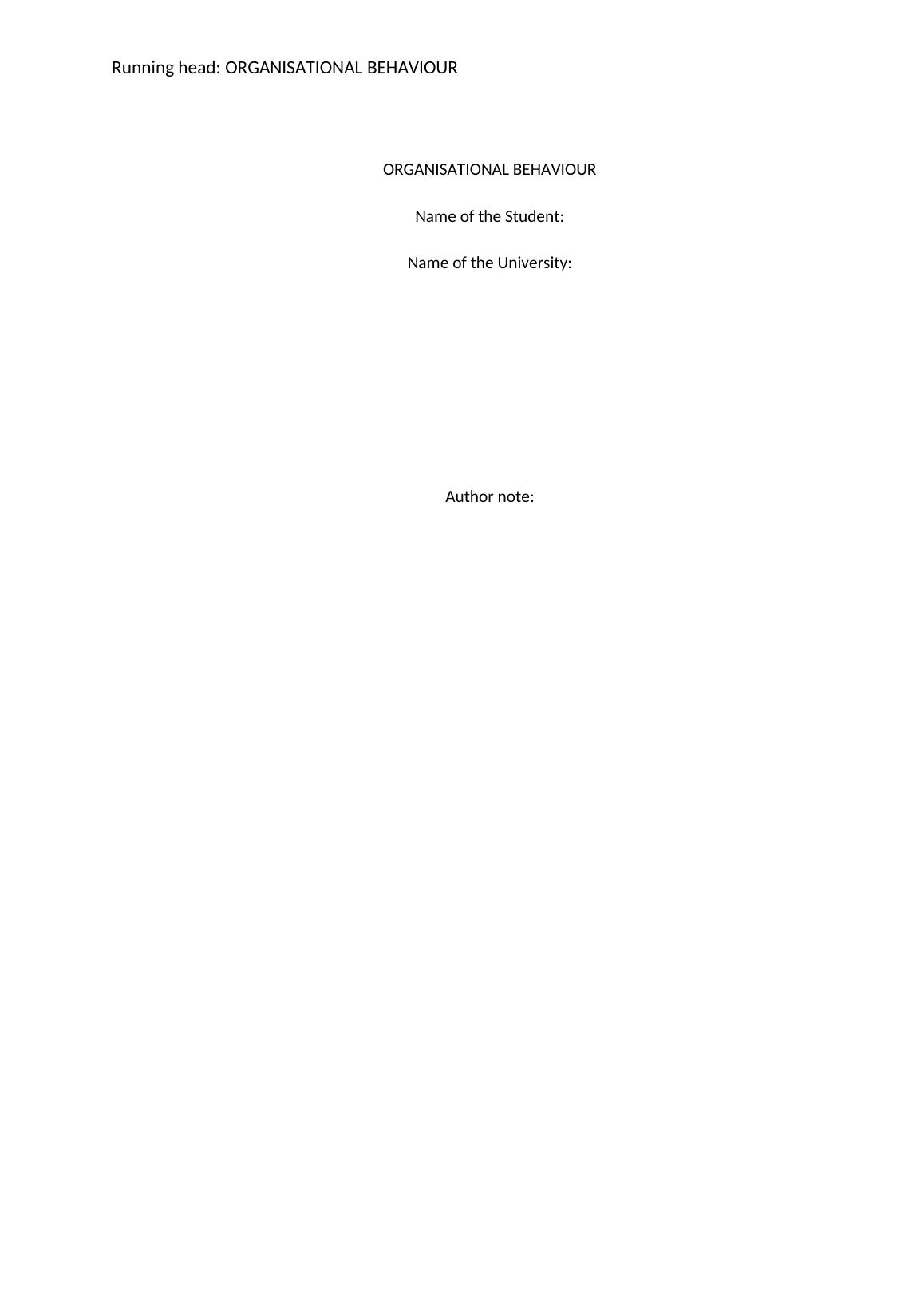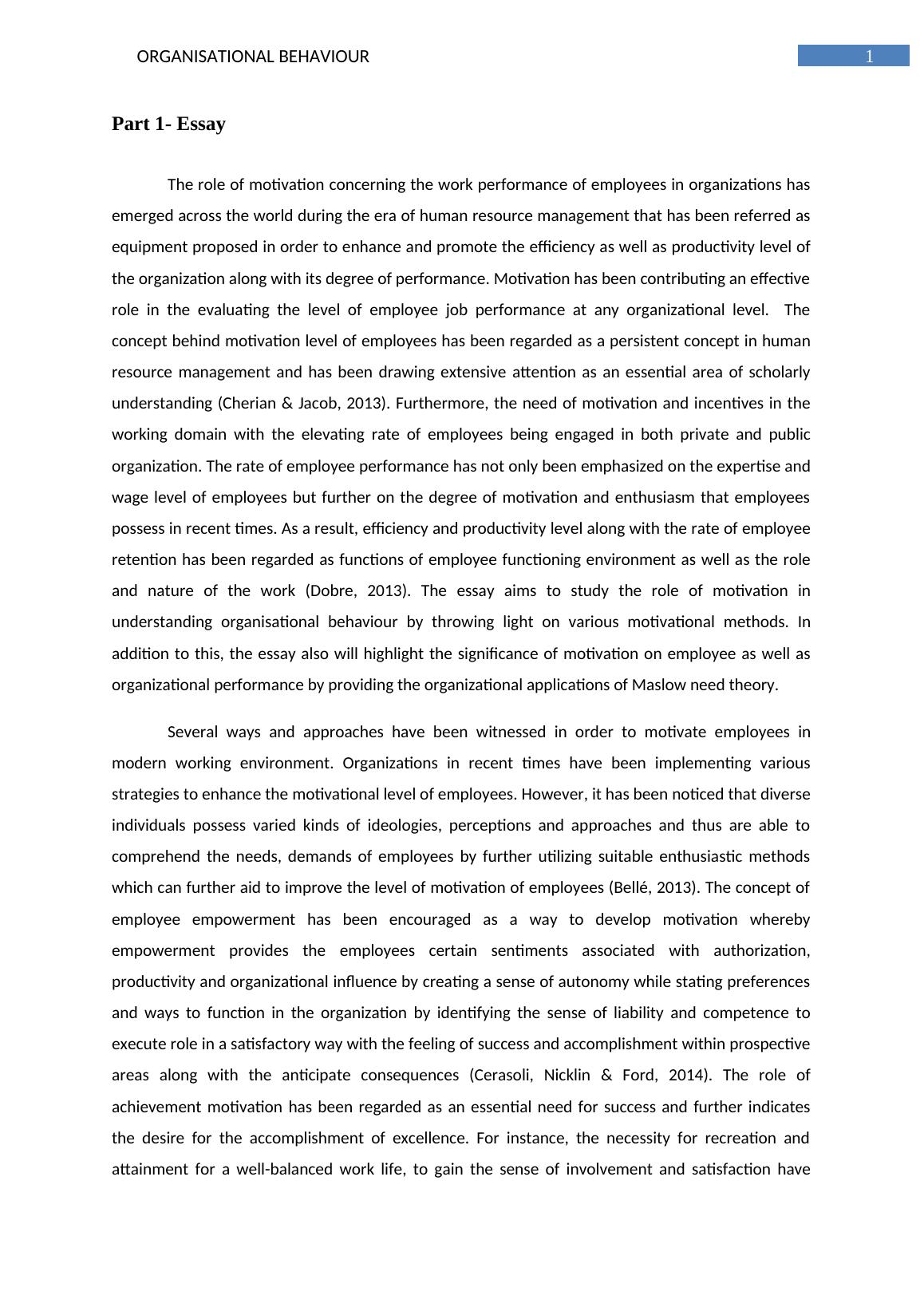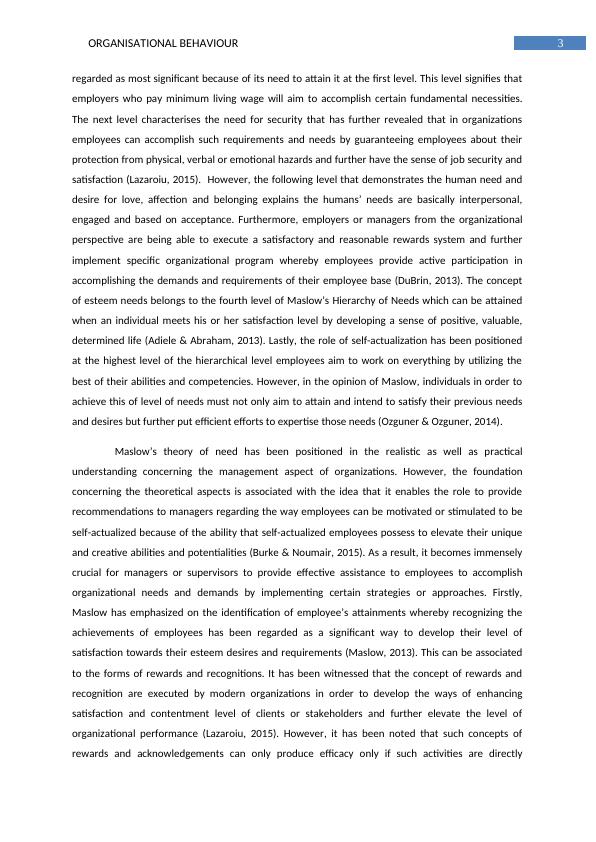Organisational Behaviour - Assignment
Added on 2021-05-27
12 Pages4270 Words26 Views
Running head: ORGANISATIONAL BEHAVIOURORGANISATIONAL BEHAVIOURName of the Student:Name of the University:Author note:

1ORGANISATIONAL BEHAVIOURPart 1- Essay The role of motivation concerning the work performance of employees in organizations hasemerged across the world during the era of human resource management that has been referred asequipment proposed in order to enhance and promote the efficiency as well as productivity level ofthe organization along with its degree of performance. Motivation has been contributing an effectiverole in the evaluating the level of employee job performance at any organizational level. Theconcept behind motivation level of employees has been regarded as a persistent concept in humanresource management and has been drawing extensive attention as an essential area of scholarlyunderstanding (Cherian & Jacob, 2013). Furthermore, the need of motivation and incentives in theworking domain with the elevating rate of employees being engaged in both private and publicorganization. The rate of employee performance has not only been emphasized on the expertise andwage level of employees but further on the degree of motivation and enthusiasm that employeespossess in recent times. As a result, efficiency and productivity level along with the rate of employeeretention has been regarded as functions of employee functioning environment as well as the roleand nature of the work (Dobre, 2013). The essay aims to study the role of motivation inunderstanding organisational behaviour by throwing light on various motivational methods. Inaddition to this, the essay also will highlight the significance of motivation on employee as well asorganizational performance by providing the organizational applications of Maslow need theory. Several ways and approaches have been witnessed in order to motivate employees inmodern working environment. Organizations in recent times have been implementing variousstrategies to enhance the motivational level of employees. However, it has been noticed that diverseindividuals possess varied kinds of ideologies, perceptions and approaches and thus are able tocomprehend the needs, demands of employees by further utilizing suitable enthusiastic methodswhich can further aid to improve the level of motivation of employees (Bellé, 2013). The concept ofemployee empowerment has been encouraged as a way to develop motivation wherebyempowerment provides the employees certain sentiments associated with authorization,productivity and organizational influence by creating a sense of autonomy while stating preferencesand ways to function in the organization by identifying the sense of liability and competence toexecute role in a satisfactory way with the feeling of success and accomplishment within prospectiveareas along with the anticipate consequences (Cerasoli, Nicklin & Ford, 2014). The role ofachievement motivation has been regarded as an essential need for success and further indicatesthe desire for the accomplishment of excellence. For instance, the necessity for recreation andattainment for a well-balanced work life, to gain the sense of involvement and satisfaction have

2ORGANISATIONAL BEHAVIOURbeen posed as an influential motivating factor for employees (Bellé, 2013). Furthermore, the idea ofgrowth motivation has been linked to the progress and development that has been aiding toemployee retention. At this juncture, it must be noted that well-contented employees have higherrate of enthusiasm, inclination, determination and reflect greater degree of ambitiousness. Well-motivated employees look for enhanced opportunity avenues, to gain increase knowledge anddevelop improved skills in order to broaden their network and further to confront the employeeswith varied positions and roles (Pinder, 2014). Providing incentives and further stimulating thedevelopment of motivation has been considered as a fundamental approach of increasing themotivational level of employees. Several observations have revealed that the concept of employeemotivation and enthusiasm has been perceived as a decisive influence on the degree oforganizational productivity whereby enterprises with greater presence of motivation have ensuredhigh rate of cooperation and the feeling of dedication and contentment within the domain of itsinfluence and authority (Cerasoli & Ford, 2014). It must be identified that motivation acts as asignificant factor to both an individual and the organization. However, the idea concerningmotivation has been identified as a critical factor for an individual that stimulates an individual toaccomplish objectives and goals. However, for an organization the role of motivation has beenregarded as a dimension that results to greater level of employee morale and satisfaction.Furthermore, motivation as a method has been acknowledging individuals to expand an individual’sarea of expertise and skills and to evaluate the competence level and potentialities (Jex & Britt,2014). The evaluation of factors associated with motivation can be viewed from the psychologicalperspective that has been regarded as a recent and challenging concept. It has been distinguishedthat content theories of motivation concerns the recognition of personal needs and desires whileprocess theoretical aspects have fundamentally been revolving around the ideas reflecting thebehavioural patterns of employees within the organization. It must be noted that the properunderstanding of ideas related to needs and rewards must be recognized in order to comprehendthe aspects of both content and process theories (Jerome, 2013). The ideological dimensions ofcontent characterize the efforts and performance to categorize these shared needs associated withparticular categorizations (Kaur,2013). The level of employee performance in an organization isimmensely dependent on the motivational roles in order to satisfy the needs and demands ofemployees. Renowned psychologists such as Maslow has focused on the aspects of human needsand the way the theoretical perspectives have been associated with organizational management(Zameer et al., 2014). Maslow’s Hierarchy of Needs has begun with the lowest level of need that isthe physiology requirements which incorporates essential needs for human existence and is thus

3ORGANISATIONAL BEHAVIOURregarded as most significant because of its need to attain it at the first level. This level signifies thatemployers who pay minimum living wage will aim to accomplish certain fundamental necessities.The next level characterises the need for security that has further revealed that in organizationsemployees can accomplish such requirements and needs by guaranteeing employees about theirprotection from physical, verbal or emotional hazards and further have the sense of job security andsatisfaction (Lazaroiu, 2015). However, the following level that demonstrates the human need anddesire for love, affection and belonging explains the humans’ needs are basically interpersonal,engaged and based on acceptance. Furthermore, employers or managers from the organizationalperspective are being able to execute a satisfactory and reasonable rewards system and furtherimplement specific organizational program whereby employees provide active participation inaccomplishing the demands and requirements of their employee base (DuBrin, 2013). The conceptof esteem needs belongs to the fourth level of Maslow’s Hierarchy of Needs which can be attainedwhen an individual meets his or her satisfaction level by developing a sense of positive, valuable,determined life (Adiele & Abraham, 2013). Lastly, the role of self-actualization has been positionedat the highest level of the hierarchical level employees aim to work on everything by utilizing thebest of their abilities and competencies. However, in the opinion of Maslow, individuals in order toachieve this of level of needs must not only aim to attain and intend to satisfy their previous needsand desires but further put efficient efforts to expertise those needs (Ozguner & Ozguner, 2014). Maslow’s theory of need has been positioned in the realistic as well as practicalunderstanding concerning the management aspect of organizations. However, the foundationconcerning the theoretical aspects is associated with the idea that it enables the role to providerecommendations to managers regarding the way employees can be motivated or stimulated to beself-actualized because of the ability that self-actualized employees possess to elevate their uniqueand creative abilities and potentialities (Burke & Noumair, 2015). As a result, it becomes immenselycrucial for managers or supervisors to provide effective assistance to employees to accomplishorganizational needs and demands by implementing certain strategies or approaches. Firstly,Maslow has emphasized on the identification of employee’s attainments whereby recognizing theachievements of employees has been regarded as a significant way to develop their level ofsatisfaction towards their esteem desires and requirements (Maslow, 2013). This can be associatedto the forms of rewards and recognitions. It has been witnessed that the concept of rewards andrecognition are executed by modern organizations in order to develop the ways of enhancingsatisfaction and contentment level of clients or stakeholders and further elevate the level oforganizational performance (Lazaroiu, 2015). However, it has been noted that such concepts ofrewards and acknowledgements can only produce efficacy only if such activities are directly

End of preview
Want to access all the pages? Upload your documents or become a member.
Related Documents
Sample Assignment on Leadership (Docs)lg...
|9
|2557
|53
Study on Organisational Behaviourlg...
|8
|1822
|155
Reflective Essay: Impact of Organisational Behaviourlg...
|6
|1531
|358
Motivation and Decision-making in Organizational Behavior and Managementlg...
|12
|2901
|65
Organizational Performance and Motivationlg...
|16
|3932
|34
Managing Human Resource Essaylg...
|11
|3501
|24
